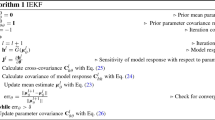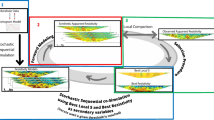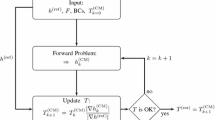Abstract
A gradient-based inverse method, the sequential self-calibrated method (SSC), has been developed to identify a parameter for the statistical distribution function of a conductivity field, a correlation length. The identification is based on a tracer test data and some conductivity measurements. Correlation length is an important parameter for geostatistical description of a conductivity distribution. It is generally difficult to obtain from limited field measurements, especially in the horizontal direction, because the measurement in this direction is generally limited and sparsely populated. When the SSC method is used to estimate conductivity statistical distribution conditioned upon tracer test data, the closer the chosen correlation length to the real value, the faster the convergence rate, which is the basis of the identification method proposed in this study. The study results indicate the correlation length can be well determined by the tracer data and some conductivity measurements. In comparison with the identification of correlation length with only conductivity measurement, with tracer test data, much less measurement is required.









Similar content being viewed by others
References
Capilla J, Gómez-Henández J, Sahuquillo A (1997) Stochastic simulation of transmissivity fields conditional to both transmissivity and piezometric data, 2. Demonstration on a synthetic aquifer. J Hydrol 203:175–188
Capilla J, Gómez-Henández J, Sahuquillo A (1998) Stochastic simulation of transmissivity fields conditional to both transmissivity and piezometric data, 3. Application to the Culebra formation at the Waste Isolation Pilot Plant (WIPP). New Mexico, USA. J Hydrol 207:254–269
Carrera J, Medina A, Galarza G(1993) Groundwater inverse problem: discussion on geostatistical formulations and validation. Hydrogeologie 4:313–324
Dagan G (1985) Stochastic modeling of groundwater flow by unconditional and conditional probabilities: the inverse problem. Water Resour Res 21:65–72
Datta-Gupta A, Vasco DW, Long, JCS, Vomvoris S (1994) Stochastic modeling of spatial heterogeneities conditioned to hydraulic and tracer tests. In: Proceedings of the 5th annual international conference on high level radioactive waste management. Am Soc Civ Eng Reston, Va 4:2624–2632
Datta-Gupta A, Lake LW, Pope GA (1995) Characterizing heterogeneous permeable media with spatial statistics and tracer data using sequential simulation annealing. Math Geol 27:763–787
Datta-Gupta A, Vasco DW, Long JCS (1997) On the sensitivity and spatial resolution of transient pressure and tracer data for heterogeneity characterization. SPE Form Eval 12:137–144
Deutsch CV, Journel AG (1998) GSLIB geostatistical software library and user’s guide. 2nd edn. Oxford University Press, Oxford
Gómez-Henández JJ, Sahuquillo A, Capilla JE (1997) Stochastic simulation of transmissivity fields conditional to both transmissivity and piezometric data, 1. The theory. J Hydrol 203:162–174
Gutjahr AL, Wilson JL (1989) Cokriging for stochastic models. Transp Porous Media 4:585–598
Harvey CF, Gorelick SM (1995) Mapping hydraulic conductivity: sequential conditioning with measurements of solute arrival time, hydraulic head, and local conductivity. Water Resour Res 31:1615–1626
He C, Hu BX (2005) Using the sequential self-calibration method and genetic algorithm method to optimally design tracer test to estimate conductivity distribution. Transp Porous Media (in press)
Hoeksema RJ, Kitanidis PK (1984) An application of the geostatistical approach to the inverse problem in the two-dimensional groundwater modeling. Water Resour Res 20:1003–1020
Huang H, Hu BX, Wen X-H, Shirley C (2004) A self-sequential calibration method for hydraulic conductivity distribution conditioned on tracer test results, Water Resour Res 40, W01506, DOI 10.1029/2003WR002253
Kitanidis PK, Vomvoris EG (1983) A geostatistical approach to the inverse problem in groundwater modeling (steady state) and one-dimensional simulations. Water Resour Res 19:677–690
Li B, Yeh T-CJ (1999) Cokringing estimation of the conductivity field under variably saturated flow conditions. Water Resour Res 35:3663–3674
McLaughlin D, Townley LR (1996) A reassessment of the groundwater inverse problem. Water Resour Res 32:1131–1162
Rubin Y, Dagan G (1987) Stochastic identification of transmissivity and effective recharge in steady groundwater flow, 1, Theory. Water Resour Res 23:1185–1192
Rubin Y, Dagan G (1992) Conditional estimation of solute travel time in heterogeneous formations: Impact of transmissivity measurements, Water Resour Res 28:1033–1040
Sun N-Z (1994) Inverse problem in groundwater modeling. Kluwer, Norwell, Mass
Tompson AFB, Arabov R, Gelhar L (1989) Implementation of the three-dimensional turning bands random fields generator. Water Resour Res 25(10):2227–2243
Wen X-H, Gómez-Henández JJ, Capilla JE, Sahuquillo A (1996) Significance of conditioning to piezometric head data for predictions of mass transport in groundwater modeling, Math Geol 28:951–968
Wen X-H, Capilla JE, Deutsch CV, Gómez-Henández JJ, Cullick AS (1999) A program to create permeability fields that honor single-phase flow rate and pressure data. Comput Geosci 25:217–230, 1131
Wen X-H, Deutsch CV, Cullick AS (2002) Construction of geostatistical aquifer models integrating dynamic flow and tracer data using inverse technique. J Hydrol 255:151–168
Yeh WWG (1986) Review of parameter identification procedures in groundwater hydrology: the inverse problem. Water Resour Res 22:95–108
Yeh T-C J, Zhang J (1996) A geostatistical inverse method for variably saturated flow in the vadose zone. Water Resour Res 32:2757–2766
Zhang J, Yeh T-C J (1997) An iterative geostatistical inverse method for steady flow in the vadose zone. Water Resour Res 33:63–71
Zimmerman DA, de Marsily G, Gotway CA, Marrietta MG, Axness CL, Beauheim RL, Bras RL, Carrera J, Dagan G, Davies PB, Gallegos DP, Galli A, Gómez-Hernádez J, Grindrod P, Gutjahr AL, Kitanidis PK, Lavenue AM, McLaughlin D, Neuman SP, RamaRao BS, Ravenne C, Rubin Y (1998) A comparison of seven geostatistically based inverse approaches to estimate transmissivities for modeling advective transport by groundwater flow. Water Resour Res 34:1373–1413
Acknowledgments
This work was funded by the U.S. Army Research Office under contract DAAD-DAAD19-02-1-0091.
Author information
Authors and Affiliations
Corresponding author
Rights and permissions
About this article
Cite this article
Hu, B.X., He, C. Using sequential self-calibration method to estimate a correlation length of a log-conductivity field conditioned upon a tracer test and limited measured data . Stoch Environ Res Ris Assess 21, 89–96 (2006). https://doi.org/10.1007/s00477-006-0046-5
Published:
Issue Date:
DOI: https://doi.org/10.1007/s00477-006-0046-5




